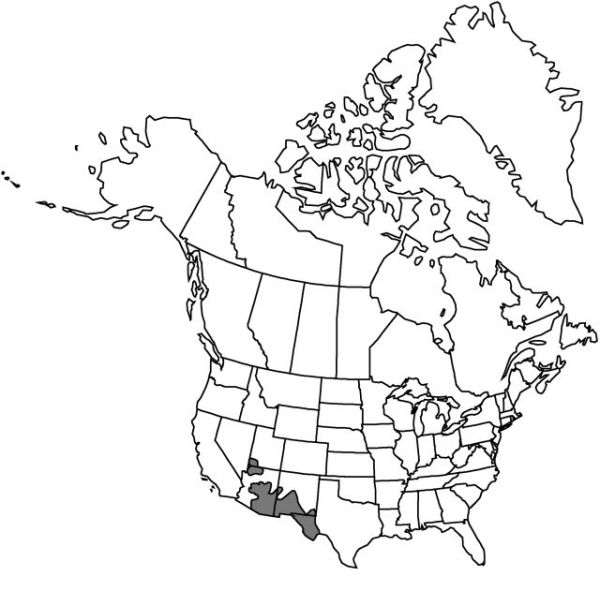Yucca elata
Bot. Gaz. 7: 17. 1882.
Plants solitary or forming small colonies of rosettes, caulescent or rarely acaulescent, distinctly arborescent, mostly few-branched, 1.2–4.5 m; rosettes usually large, symmetrical or asymmetrical. Stems 1–7 per colony, erect, thick, 1–1.5 (–2.5) m. Leaf-blade pale green, linear, widest near middle, 25–95 × 0.2–1.3 cm, flexible, margins entire, curled, filiferous, whitish, apex tapering to short spine. Inflorescences mostly paniculate, sometimes distally racemose, arising beyond rosettes, mostly narrowly ovoid to ovoid, 7–15 × 2.5–6.5 dm; branches 0.7–3.5 dm; bracts erect; peduncle sometimes scapelike, 1–2 m, 2.5–5.5 cm diam. Flowers pendent; perianth campanulate or globose; tepals distinct, creamy white, often tinged green or pink, narrow to broadly elliptic or ovate, 3.2–5.7 × 1.3–3.2 cm; filaments 1.5–2.5 (–3.2) cm, pubescent; anthers (2–) 2.5–4.8 mm; pistil 2–3.2 × 0.6–1 cm; style white or pale green, 6–11 mm; stigmas lobed. Fruits erect, capsular, dehiscent, oblong-cylindric, symmetrical or rarely constricted, 4–8.2 × 2–4 cm, dehiscence septicidal. Seeds dull black, thin, 7–11 (–14) mm diam.
Distribution

North America, Mexico
Discussion
Varieties 2 (2 in the flora).
J. L. Reveal (1977c) reduced S. D. McKelvey’s (1938–1947) Yucca utahensis and Y. verdiensis to varieties of Y. elata based primarily u!pon growth forms. J. M. Webber (1953) considered that these taxa are populations of hybrids between members of the Y. glauca alliance of the Great Plains and Y. elata of the American Southwest. Reveal believed that Webber did not provide adequate justification for his hybrid hypothesis. K. H. Clary (1997, pers. comm.) believes that Y. utahensis is genetically distinct from Y. elata and Y. verdiensis, based on DNA evidence and the morphological characters of style, stigma, fruit, and leaf. Her DNA evidence shows that Y. elata and Y. verdiensis are sister taxa, while Y. utahensis is not. Although there is a great range of variation within Y. elata as circumscribed here, the two varieties recognized are difficult to distinguish.
Selected References
None.
Lower Taxa
Key
| 1 | Capsules 5–8.2 cm; pistil 2.8–3.2 cm; leaf blade 30–95 cm. | Yucca elata var. elata |
| 1 | Capsules 4–4.5 cm; pistil 2–2.5 cm; leaf blade 25–45 cm. | Yucca elata var. verdiensis |
"thick" is not a number. "thin" is not a number."dm" is not declared as a valid unit of measurement for this property."dm" is not declared as a valid unit of measurement for this property."dm" is not declared as a valid unit of measurement for this property."thin" is not a number.